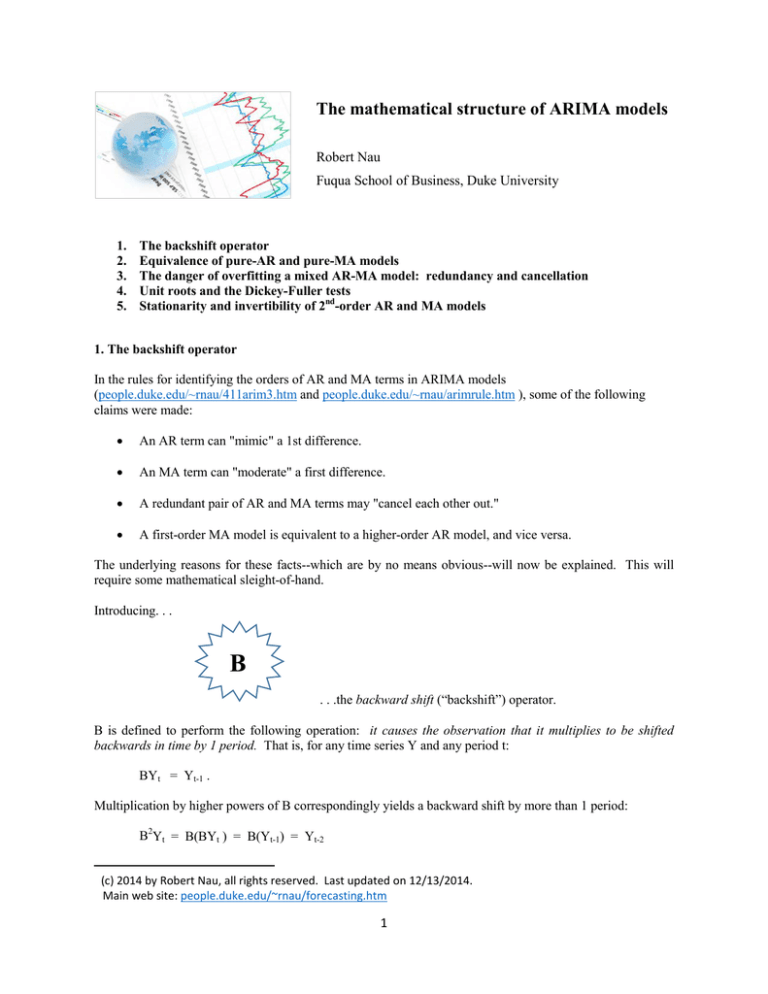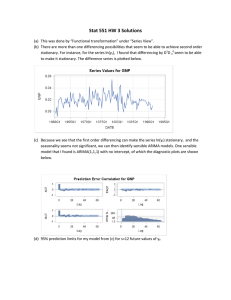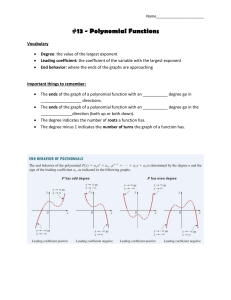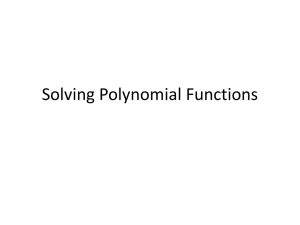
The mathematical structure of ARIMA models
Robert Nau
Fuqua School of Business, Duke University
1
1.
2.
3.
4.
5.
The backshift operator
Equivalence of pure-AR and pure-MA models
The danger of overfitting a mixed AR-MA model: redundancy and cancellation
Unit roots and the Dickey-Fuller tests
Stationarity and invertibility of 2nd-order AR and MA models
1. The backshift operator
In the rules for identifying the orders of AR and MA terms in ARIMA models
(people.duke.edu/~rnau/411arim3.htm and people.duke.edu/~rnau/arimrule.htm ), some of the following
claims were made:
•
An AR term can "mimic" a 1st difference.
•
An MA term can "moderate" a first difference.
•
A redundant pair of AR and MA terms may "cancel each other out."
•
A first-order MA model is equivalent to a higher-order AR model, and vice versa.
The underlying reasons for these facts--which are by no means obvious--will now be explained. This will
require some mathematical sleight-of-hand.
Introducing. . .
B
. . .the backward shift (“backshift”) operator.
B is defined to perform the following operation: it causes the observation that it multiplies to be shifted
backwards in time by 1 period. That is, for any time series Y and any period t:
BYt = Yt-1 .
Multiplication by higher powers of B correspondingly yields a backward shift by more than 1 period:
B2Yt = B(BYt ) = B(Yt-1) = Yt-2
1
(c) 2014 by Robert Nau, all rights reserved. Last updated on 12/13/2014.
Main web site: people.duke.edu/~rnau/forecasting.htm
1
…and in general, for any integer n:
BnYt = Yt-n
Thus, multiplying by B-to-the-nth-power has the effect of shifting an observation backwards by n periods.
The first-difference operation has a simple representation in terms of B. Suppose that y is the first difference
of Y. Then, for any t:
yt = Yt − Yt-1 = Yt − BYt = (1−B)Yt
Thus, the differenced series y is obtained from the original series Y by multiplying by a factor of 1−B. Now,
if z is the first difference of y, i.e., z is the second difference of Y, then we have:
zt = yt − yt-1 = (1−B) yt = (1−B)((1−B)Yt) = (1−B)2Yt .
The second difference of Y is therefore obtained by multiplying by a factor of (1−B)2, and in general the dth
difference of Y would be obtained by multiplying by a factor of (1−B)d.
Note that what we are doing here is manipulating the operation of shifting-in-time as though it were a
numeric variable in an equation. This is perfectly legitimate, because B is a linear operator, and we will see
shortly that such manipulations can be pushed to crazy-but-useful lengths.
Armed with B, let's reconsider the ARIMA(1,1,1) model for the time series Y. For convenience, I will omit
the constant term from this model and all the models discussed below. (The presence of a constant term
would not change the basic arguments, but it would complicate the details.) The ARIMA(1,1,1) model (sans
constant) is defined by the following pair of equations: 2
yt = Yt − Yt-1
yt = φ1 yt-1 + et − θ1 et-1
…where et is the random shock (noise) occurring at time t. Armed with the backshift operator, we can now
rewrite them as follows:
yt = (1−B)Yt
yt = φ1Byt + et − θ1Bet
By collecting y's on the left and e's on the right, the second equation can be rewritten as:
(1−φ1B)yt = (1−θ1B)et
We can now substitute the expression for y in terms of Y that was given by the first equation, obtaining a
single equation involving Yt and et that summarizes the ARIMA(1,1,1) model:
(1-φ1B)(1-B)Yt = (1-θ1B)et
2
Some authors define θ1 (and higher-order MA coefficients, if any) to have the opposite sign, so that this equation
would be yt = φ1 yt-1 + et + θ1 et-1. The convention followed here is the one used by Box and Jenkins.
2
To put this in perspective, recall our most basic forecasting model, namely the mean model. In the special
case where the mean is assumed to be zero, this model simply asserts that "Y is stationary white noise," i.e.:
Yt = et
In our new jargon, we could call this model an ARIMA(0,0,0) model. Now, the ARIMA(1,1,1) model is
merely obtained by adding bells and whistles to it. Instead of "Yt equals et," the ARIMA(1,1,1) model asserts
that "something times Yt " equals "something times et." In particular:
•
Including a first difference is equivalent to multiplying Yt by a factor of 1−B
•
Including an AR(1) term is equivalent to multiplying Yt by a factor of 1−φ1B
•
Including an MA(1) term is equivalent to multiplying et by a factor of 1−θ1B
This explains some of the facts about ARIMA models that were noted above:
•
If the AR(1) coefficient, denoted φ1, is close to 1, then the factor 1−φ1 B on the left side of the
ARIMA equation is almost the same as a factor of 1−B. Now, each factor of 1−B appearing on the
left side of the equation represents an order of differencing. Hence the AR(1) term is mimicking an
additional order of differencing if its estimated coefficient turns out to be close to 1.
•
If the MA(1) coefficient, denoted θ1, is close to 1, then the factor 1−θ1B on the right side of the
equation is approximately the same as a factor of 1−B. In this case, the factor of 1−B on the left side
of the equation (representing a first difference) is "almost cancelled" by factor of 1−θ1B on the right.
Thus, an MA(1) term can seemingly reduce the order of differencing if its estimated coefficient turns
out to be close to 1.
•
Suppose that the estimated value of the AR(1) coefficient, φ1, turns out to be almost equal to the
estimated value of the MA(1) coefficient, θ1. Then the factor of 1−φ1B on the left side of the
ARIMA equation is essentially cancelled by the factor of 1−θ1B on the right. This is what you
would expect to happen if neither the AR(1) term nor the MA(1) term really belonged in the model
in the first place--i.e., if they were both redundant. (More about this below…)
2. Equivalence of pure-AR and pure-MA models
Now, let's try something a little more far-out. Consider the pure MA(1) model. Its equation, in backshiftoperator notation, is:
Yt = (1−θ1B)et
Can this model be rewritten as a pure AR model? In order to do this, we need to rearrange it so as to get et
by itself on the right side of the equation, and "something times Yt" on the left. But how do we determine
what the "something" is? Well, by our usual method of solving equations, we evidently need to multiply
through by a factor of 1 divided by (1−θ1B), which may be denoted (1−θ1B)-1. We thereby obtain:
(1−θ1B)-1Yt = (1−θ1B)-1(1−θ1B)et
3
The factor of (1−θ1B)-1 then cancels the factor of (1−θ1B) on the right, leaving:
(1−θ1B)-1Yt = et.
This is fine, except… how do we interpret the factor of (1−θ1B)-1 now appearing on the left? What is the
meaning of "1 divided by 1 minus θ1 times the backshift operator?" Well, not to worry. Perhaps you recall
the formula for the infinite geometric series:
(1−r)-1 = 1 + r + r2 + r3 + r4 + . . .
. . .which is valid for |r| < 1. Let's just let r = θ1B, and see what happens:
(1−θ1B)-1 = 1 + θ1B + θ12B2 + θ13B3 + θ14B4 + . . .
Voila! The factor of "1 divided by something-involving-the-backshift-operator" has turned into a sequence
of powers of B, which we know how to interpret. The pure-AR form of the MA(1) model can therefore be
written as:
(1 + θ1B + θ12B2 + θ13B3 + θ14B4 + . . . )Yt = et
. . .which, in view of the definition of B, really means:
Yt = −θ1Yt-1
− θ12Yt-2 − θ13Yt-3 − θ14Yt-4 − . . . + et
This is an infinite-order pure-AR model, with the AR(1) coefficient being −θ1, the AR(2) coefficient being
−θ12, and the AR(n) coefficient being −θ1n for n=3, 4, etc. to infinity.
By the same reasoning, a pure AR(1) model, whose single coefficient is φ1, is equivalent to an infinite-order
pure-MA model, in which the MA(1) coefficient is −φ1 , the MA(2) coefficient is −φ12, the MA(3) coefficient
is −φ13 and so on.
The practical significance of this is that it can be difficult to tell the difference between an MA(1) model and
an AR(2) model, or between and AR(1) model and an MA(2) model, if the first-order coefficients are not
large. For example, suppose that the "true" model for the time series is pure MA(1) with θ1 = 0.3. This is
equivalent to an infinite-order pure-AR model with:
φ1 = −θ1
= −0.3
φ2 = −θ12 = −0.09
φ3 = −θ13 = −0.027
φ4 = −θ14 = −0.0081
…and so on. Note that the AR coefficients are all negative, and their magnitudes have an exponentially
decreasing pattern. Because of the rapidity of the exponential decrease, φ3 and φ4 and all higher-order
coefficients are not significantly different from zero, at least within the precision with which ARIMA
coefficients can be estimated from typical-sized data sets, and φ2 is not very large either. Hence, for practical
purposes, this is a 2nd-order AR model rather than an infinite-order AR model. But in such a case, you should
generally choose the simpler representation (here, MA(1)) on grounds of simplicity.
4
3. The danger of overfitting a mixed AR-MA model: redundancy and cancellation
Now let's consider the issue of a pair of AR and MA factors cancelling each other out (a so-called "common
factor" problem). Suppose the time series Y is really an ARIMA(1,d,0) process, but instead you attempt to
fit an ARIMA(2,d,1) model. The ARIMA(2,d,1) model has the equation:
yt = φ1 yt-1 + φ2 yt-2 + et − θ1et-1
where yt = (1−B)d Yt. In terms of the backshift operator this can be rewritten as:
(1 − φ1B − φ2B2 ) yt = (1 − θ1B)et .
Note that the object multiplying yt on the left side is a second-order polynomial in B, which is called the “AR
polynomial” for this model. Like any polynomial, it can be factored into a product of first-order terms:
(1 − φ1 B − φ2 B2) = (1 − λ1B)(1 − λ2B)
Here, λ1 and λ2 are two numbers that are called the "inverse roots" of the AR polynomial. In practice, these
can be determined by applying a specialized form of the quadratic formula:
λ = (φ1 ± SQRT(φ12 + 4φ2 )))/2
For example, if φ1
=
0.8 and φ2
=
−0.15, we find:
λ = (0.8 ± SQRT(0.82 + 4(−0.15)))/2
= (0.8 ± SQRT(0.04))/2
= (0.8 ± 0.2)/2
...which has solutions λ1 = 0.5 and λ2 = 0.3. Thus, the AR(2) polynomial in this case can be factored as
follows:
(1 − 0.8B + 0.15B2) = (1 − 0.5B)(1 − 0.3B)
Note that if the quantity whose square root is computed in the quadratic formula, namely φ12 + 4φ2, is
negative, then the inverse roots will be complex numbers, i.e., partly "real" and partly "imaginary." This
occurs in AR(2) processes exhibiting sine-wave oscillations.
By factoring the AR polynomial, the ARIMA(2,d,1) equation can be rewritten:
(1 − λ1B)(1 − λ2B) yt = (1 − θ1B)et
It is now apparent how cancellation might occur: if λ2 = θ1, then the AR factor of 1−λ2B on the left is
cancelled by the MA factor of (1−θ1B) on the right, so the equation reduces to:
(1 − λ1B) yt = et
which is an ARIMA(1,d,0) model.
For example, suppose the true AR(1,d,0) model has φ1 = 0.5, i.e.:
5
(1 − 0.5B)yt = et
This is equivalent to an ARIMA(2,d,1) model with φ1 = 0.8, φ2 = −0.15, and θ1 = 0.3:
(1 − 0.8B + 0.15B2)yt = (1 − 0.3B)et
…since, as we saw above, the AR(2) polynomial on the left can be factored as (1−0.5B)(1−0.3B). Thus, one
AR factor (namely 1−0.5B) represents the true autoregressive effect in this case, and the other AR factor
(namely 1−0.3B) merely serves to cancel out the superfluous MA(1) factor.
The problem here is that if the true data generating process is ARIM(1,d,0) but the model is specified as
ARIMA(2,d,1), it is not uniquely identified, because many ARIMA(2,d,1) models can be equivalent to the
same ARIMA(1,d,0) model. For example, consider the ARIMA(2,d,1) model with φ1 = 0.9, φ2 = −0.2, and
θ1 = 0.4:
(1 − 0.9B + 0.2B2 )yt = (1 − 0.4B)et
This can be factored as:
(1 − 0.5B)(1 − 0.4B) yt = (1 − 0.4B)et
…which, after cancellation, again reduces to:
(1 − 0.5B) yt = et
So, if you try to fit an ARIMA(2,d,1) model to a time series that is really ARIMA(1,d,0), the least-squares
coefficient estimates will not be unique. Sometimes (but not always) this problem will be signaled by the
fact that the estimation algorithm will fail to converge in a reasonable number of iterations (say, less than 10)
and/or it will yield suspiciously large values for the coefficients.
The same reasoning would apply if you attempted to fit an ARIMA(1,d,2) model to a time series that was
really (0,d,1): in this case the MA side of the model would be a 2nd-order polynomial in B, with one
superfluous factor. More generally, a common-factor problem may arise whenever the true model is
ARIMA(p,d,q) but instead you attempt to fit an ARIMA(p+1,d,q+1) or ARIMA(p,d+1,q+1) model. Note,
however, that in a redundant mixed model in which at least one side (AR or MA) is 2nd- or higher-order, the
common factor may not be obvious. Instead, it may be buried in the roots of the AR and/or MA polynomials.
The moral: beware of trying to estimate multiple AR coefficients and multiple MA coefficients
simultaneously, because this may just lead to cancellation of factors on both sides of the equation. Instead,
you should (i) try to use pure-AR or pure-MA models, rather than mixed AR-MA models, unless the data
clearly indicates otherwise; and (ii) use the "forward stepwise" approach to model-identification, rather than
"backwards stepwise." You may sometimes find a series which, after suitable differencing, has spikes at lags
1 and 2 in both the ACF and PACF, making it hard to choose between an ARIMA(2,d,0) model and a
ARIMA(0,d,2) model. In this case, it may happen that an ARIMA(1,d,1) model gives the best fit. Since
there is only one AR coefficient and one MA coefficient, it is easy to detect a problem with cancellation: if
the estimated AR and MA coefficients are nearly equal, then cancellation has occurred. Otherwise, it hasn't.
In particular, if the estimated AR and MA coefficients turn out to have opposite signs, there is no problem.
You sometimes encounter situations in which the best model has 2 or 3 terms of one kind (AR or MA) and 1
of the other, e.g., ARIMA(3,0,1) or ARIMA(1,1,2). (The latter is a damped-trend linear exponential
6
smoothing model.) But you should avoid using models with 2 or more terms of both kinds unless you have a
good-sized sample of clean data and it was generated by a process that can be reasonably expected to have
very stable dynamics (which is often not true of data in business and economics). ARIMA (2,1,2) models are
commonly among the suspects tested by automatic forecasting software, and if you are tempted to use such a
model, be sure to take a close look at the inverse roots to look for cancellation or nonstationarity or
noninvertibility, and see if you get almost as good a fit, as well as plausible-looking forecasts and confidence
limits, by reducing q by 1 while simultaneously reducing either p or d by 1. Also think about how you would
explain the logic of the model to someone else, and do some more research to see what models others have
applied to similar data, but be skeptical about models that are overly complex. (I've seen articles on the web
proposing models such as (3,1,3) for economic data. Don't go there.)
4. Unit roots and the Dickey-Fuller tests
The "roots" of an AR(p) polynomial are the real or complex numbers {r} that satisfy (1 − φ1r − φ2r2 − ...
− φprp ) = 0, and they must all lie outside the unit circle in order for the model for y to be stationary, i.e., to
yield forecasts that eventually converge to the mean when they are extrapolated far into the future.
(Equivalently, the inverse roots must all lie inside the inside circle.) Furthermore, the roots of an MA(q)
polynomial (1 − θ1r − θ2r2 ... − θqrq ) must all lie outside the unit circle in order for the model to be
invertible, i.e., capable of estimating the "true" errors or shocks that gave rise to the observed series. If the
model is not invertible, the residuals cannot be considered as estimates of the true random shocks.
Some software packages (alas, not Statgraphics) will routinely compute and print out the roots (or inverse
roots) of any 2nd- or higher-order AR or MA polynomials in the model, so that you can watch out for
possible cancellation, non-stationarity and/or non-invertibility. Of course, for an MA(1) or AR(1)
polynomial, the (single) inverse root is simply the coefficient, θ1 or φ1 .
If one of the roots (or inverse roots) of the AR polynomial is almost exactly equal to 1, the AR part of the
model is said to have a "unit root". In an AR(1) model, this occurs when the single estimated coefficient φ1
is equal to 1. In this case the data is telling you that another difference is what is really needed, not an AR(1)
term. At the present order of differencing, it is behaving like a random walk process.
In a 2nd- or higher-order AR model, the same reasoning applies to the roots of the AR polynomial. If one of
the roots is almost exactly to 1, then the time series has not been adequately stationarized, and it probably
would be better to use one more nonseasonal difference and one less AR coefficient in the model. For
example, if an ARIMA(2,0,0) model has a unit root in the AR polynomial, it would probably be better to use
an ARIMA(1,1,0) model instead.
There is an easy way to check for the occurrence of a unit root in the AR polynomial: just add up all the AR
coefficients. If the sum is very close to 1.0, then the polynomial may have a unit root, indicating that you
ought to try increasing the order of nonseasonal differencing and decreasing the number of AR terms. How
close? Within 0.05 is a rough rule of thumb for a red flag, but for a bit more rigor, you can perform a
statistical test for the presence of a unit root by checking to see whether the difference between 1 and the sum
of the AR coefficients is significantly different from zero. This is known as the Dickey-Fuller test in the case
of an AR(1) model, and the augmented Dickey-Fuller test in the case of an AR(p) model with p>1. Let Y
denote the time series of interest and let y denote its first difference. For the case in which Y is believed to
be an AR(1) process, the Dickey-Fuller test for the presence of a unit root is to regress y on Y lagged by 1
period. If there is a unit root, then the coefficient of Y lagged by 1 period in this model should not be
significantly different from zero, which can be tested in the usual way by looking at its t-statistic. For the
case in which Y is believed to be an AR(p) process, p>1, the augmented Dickey-Fuller test for the presence
of a unit root is to regress y on itself lagged by 1 period, 2 periods, etc., up to p-1 periods, together with Y
lagged by 1 period. (In the AR(2) case, the independent variables would just be y lagged by 1 period and Y
lagged by 1 period.) Again, if there is a unit root, then the coefficient of Y lagged by 1 period should not be
significantly different from zero, which can be tested by looking at its t-statistic.
7
In asking whether there is a unit root in the AR polynomial, you should also consider whether it is logical
that the series should be stationary (mean-reverting) at its current level of differencing. If it is logical to think
that it is stationary but with only very slow mean reversion, then another difference might not be appropriate,
even if there is an AR root that is very close to 1.
The same consideration applies to a regression model fitted to time series data. If Y is the dependent variable
and its first two lagged values (LAG(Y,1) and LAG(Y,2) in Statgraphics notation, or Y_LAG1 and Y_LAG2
in RegressIt notation) are included as independent variables, then a unit root is indicated if the sums of their
coefficients are not significantly different from 1. In this case it might be better to use the first difference of
Y as the dependent variable and to use its lag-1 value but not its lag-2 value as an independent variable.
The opposite consideration applies to the MA polynomial in 2nd- or higher-order MA models. If the MA
polynomial contains a unit root, it is essentially cancelling out one order of nonseasonal differencing. In this
situation (which you can test for by adding up the MA coefficients to see if the sum is close to 1.0), you
should consider using one less nonseasonal difference and one less MA term. Here too, you should stop and
think about what is logical. A nonseasonal difference combined with MA terms whose sum is very close to 1
is like an exponential smoothing model that is computing a very long-term moving average without assuming
long-run reversion to a global mean. If long-run mean reversion makes more sense, then it would be better to
reduce the order of differencing.
5. Stationarity and invertibility of 2nd-order AR or MA models
More generally, stationarity requires the roots of the AR polynomial to be outside the unit circle, not merely
off of it. (Equivalently, the inverse roots must be inside the unit circle.) The roots of an AR(2) polynomial
are outside the unit circle, and hence the model is stationary, if and only if the following constraints are
satisfied:
φ2 + φ1 < 1
φ2 − φ1 < 1.
−1 < φ2 < 1
These inequalities cover the case of complex roots as well as real roots. A unit-root situation is the special
case in which φ2 + φ1 = 1 in violation of the first of the inequalities.
Similarly, to determine whether the roots of an MA(2) polynomial are outside the unit circle, in order to
verify invertibility, you would apply these conditions with θ1 and θ2 in place of φ1 and φ2 . (Caution: be sure
you know which convention your software uses for the sign of MA coefficients. See footnote 2 on page 2.)
Again, nonstationarity suggests that a higher order of differencing should be considered, while
noninvertibility suggests that a lower order should be considered.
8









